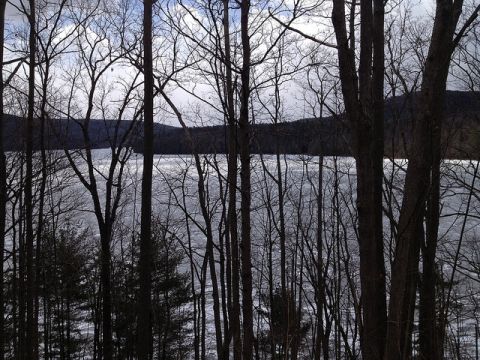
Above: The ice-covered Schoharie Reservoir in 2013. Photo via the NYC DEP's Flickr page.
An “oily sheen” was discovered on the surface of the Schoharie Reservoir, one of the sources of New York City’s upstate drinking water supply, on Monday, April 6, according to a New York City Department of Environmental Protection press release.
The spill, which appeared in a 50-foot-wide gap of water between ice on the reservoir and the shore, was located “several hundred feet down shore” from the mouth of the Shandaken Tunnel, which sends water from the Schoharie Reservoir to the city, the press release states.
The whole spill was 50 feet wide and about 900 feet long, said DEP spokesman Adam Bosch said. It had dissipated by Tuesday morning, April 7, he said.
After the sheen was discovered, at 2:30 p.m. on Monday, the DEP surrounded it with absorbent booms and shut down the tunnel’s intake chamber.
“As a result, it did not pose a threat to drinking water,” the agency's press release states.
The DEP has also placed booms around the exit of the Shandaken Tunnel, 18 miles away, where water from the Schoharie Reservoir exits into the Esopus Creek, bound for the Ashokan Reservoir and on to New York City, Bosch said.
In 2012, a similar spill was discovered coming from a pipe in the Pepacton Reservoir, another of the DEP’s upstate water supplies. That spill, which covered an area of 100 square feet, was smaller than this week’s spill in the Schoharie.
Surprises from Irene
The exact substance causing the spill in the Schoharie hasn’t been identified yet, but it was leaking from a tank that DEP officials suspect washed into the reservoir during Tropical Storm Irene in 2011.
“The tank, from what we can tell, looks to be similar in size to your typical home heating type of tank,” Bosch said.
The DEP has known about the tank since February, Bosch said. Due to a dry fall and a cold winter, the Schoharie Reservoir is unusually low, causing the top of the tank to jut up out of the water, where it was visible from the shore.
“The water got so low that the thing poked its nose out of the reservoir,” Bosch said. “We could see it, but we couldn’t remove it because it’s not safe to do that operation on ice.”
It’s likely that the tank sprang a leak after melting and shifting ice dislodged it from the mud, Bosch said.
The tank isn’t the only surprise lying in wait at the bottom of the Schoharie Reservoir. A large box that looks like a small shipping or construction container has also appeared out in in the middle of the reservoir, Bosch said.
“Based on the large amount of debris that was washed into the Schoharie Reservoir during Tropical Storm Irene, we have reason to believe that this is part of that,” Bosch said. “We’re hopeful that these are the two last things out there.”
Once the rest of the ice on the Schoharie Reservoir thaws and “conditions are safe for workers,” Bosch said, the DEP will remove both the tank and the box from the reservoir.
The DEP plans to re-open the Shandaken Tunnel, the Schoharie Reservoir's pipeline to the city, once the substance of the spill is identified, the press release states.
Update, 4/11/15: The spill has been identified as "motor oil or hydraulic oil," the DEP reported in a press release on Friday, April 10. The Shandaken Tunnel was reopened on Thursday, April 9. DEP officials say that none of the oil appears to have entered New York City's water supply. From the press release:
Oil was not found in the water samples collected from inside the intake chamber.
The sheen, which had dissipated by Tuesday, is not currently visible, nor are any odors detectable at the site. Three layers of boom remain deployed at the intake, and two layers of boom remain in place as a precaution at the tunnel outlet alongside the Esopus Creek.
On Thursday evening, DEP reactivated the Shandaken Tunnel Intake Chamber after consulting with its regulators. Local elected officials and stakeholders have also been notified. Because any lingering oil would remain in suspension atop the water, and the intake structure is located at the bottom of the reservoir, DEP is confident that none of the material will be conveyed through the Shandaken Tunnel. In addition to absorbent boom already deployed at both ends of the tunnel, DEP is taking several other steps that have been reviewed by regulators.
DEP’s water quality staff will implement an enhanced monitoring plan at the Shandaken Tunnel intake and outlet. Samples will be taken Friday, Sunday, Tuesday, and then once a week to ensure oil is absent from the water being conveyed from Schoharie Reservoir. This monitoring plan is consistent with the testing that was done after a similar sheen was discovered at Pepacton Reservoir in 2012. DEP will also conduct daily visual inspections at Schoharie Reservoir and the Shandaken Tunnel Outlet for any sign of the sheen. Coincident with these actions, DEP is working on a plan to remove the tank once the ice has melted and work conditions are safe.
Because the Shandaken Tunnel had been shut down for several days, its reactivation on Thursday evening created a brief spike in turbidity that soon returned to normal levels. DEP is currently conveying 300 million gallons per day through the tunnel.










